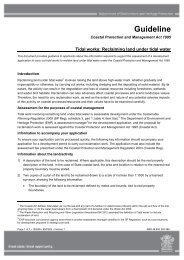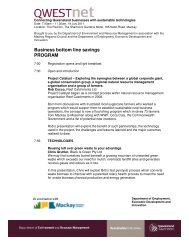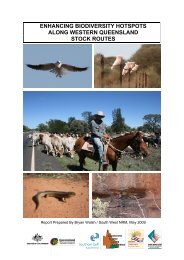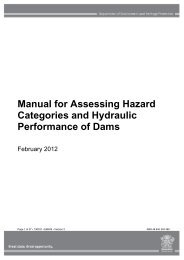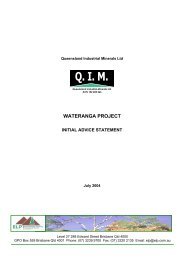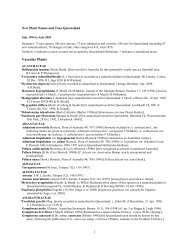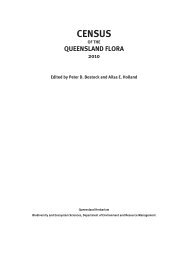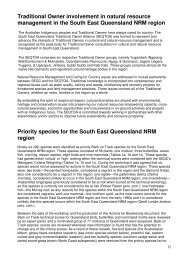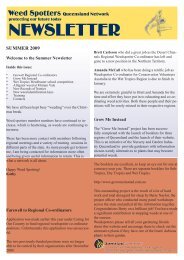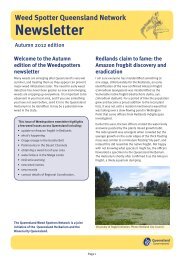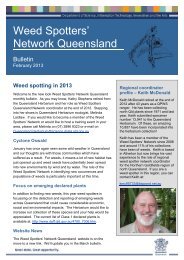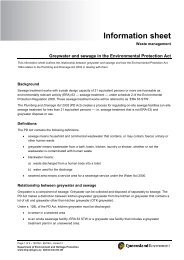Distribution, abundance and biology of Group V humpback whales ...
Distribution, abundance and biology of Group V humpback whales ...
Distribution, abundance and biology of Group V humpback whales ...
Create successful ePaper yourself
Turn your PDF publications into a flip-book with our unique Google optimized e-Paper software.
5 Migration <strong>and</strong> site fi delity<br />
The migratory potential <strong>of</strong> <strong>humpback</strong> <strong>whales</strong> is almost<br />
unlimited <strong>and</strong> individuals may migrate up to 10,000 km<br />
each year between summer feeding <strong>and</strong> winter grounds<br />
(Baker et al.1990). The <strong>humpback</strong> migration could be driven<br />
by a breeding population exhibiting strong site fi delity to<br />
natal wintering grounds <strong>and</strong> which then disperses to access<br />
prey that is only adequately abundant in Antarctic waters<br />
(Gaskin 1982).<br />
It has been hypothesized that not all <strong>Group</strong> V <strong>humpback</strong>s<br />
migrate each year either from the breeding or feeding<br />
grounds. Occasional sightings <strong>of</strong> <strong>humpback</strong>s in northern<br />
GBR waters (above 16°S Cairns) in summer supports<br />
previous claims <strong>of</strong> a sub-stock resident year round in<br />
northern Australian tropical waters (Chaloupka <strong>and</strong> Osmond<br />
1999; Simmons <strong>and</strong> Marsh 1985). Biopsy studies (Brown et<br />
al.1995) <strong>and</strong> whaling data (Chittleborough 1965) indicate<br />
that some females may remain on the feeding grounds<br />
during Austral summers.<br />
The trigger to commence migration has been attributed to<br />
reduced light conditions (Dawbin 1966), prey availability<br />
(Clapham 1996), breeding condition <strong>and</strong> water temperature.<br />
Corkeron <strong>and</strong> Connor (1999) discuss several hypotheses<br />
to explain the migration to winter breeding grounds. They<br />
conclude that the northward migration is undertaken by<br />
pregnant females to reduce the risk <strong>of</strong> killer whale Orcinus<br />
orca predation on newborn calves in low-latitude waters.<br />
In the absence <strong>of</strong> experimental evidence, it is impossible<br />
to establish which factor or factors is/are responsible for<br />
migration.<br />
The trigger to leave tropical wintering grounds <strong>and</strong> return<br />
to feeding grounds may be related to reproductive status or<br />
hunger, although Paterson (1994) suggested that breeding<br />
behaviour was a stronger urge than feeding. Dawbin (1997)<br />
stated that the fl uctuation in water temperature was too<br />
small for it to act as a trigger for migration.<br />
From the observations <strong>of</strong> a single <strong>humpback</strong> <strong>of</strong>fshore<br />
<strong>of</strong> North Stradbroke Isl<strong>and</strong>, Paterson (1994) concluded<br />
that <strong>humpback</strong>s migrated at a similar rate during the day<br />
<strong>and</strong> night. This is one <strong>of</strong> the assumptions used to model<br />
population estimates by two separate groups based on<br />
North Stradbroke Isl<strong>and</strong> (Bryden et al.1996; Paterson et<br />
al.1994). Other assumptions are detailed in Brown (1997).<br />
5.1 <strong>Group</strong> V migratory route<br />
The wintering grounds <strong>of</strong> <strong>humpback</strong>s are typically located in<br />
tropical, shallow lagoonal waters such as Hawaii, Bahamas,<br />
West Indies, the South Pacifi c isl<strong>and</strong>s (Dawbin 1959;<br />
Garrigue et al.2000) <strong>and</strong> the Great Barrier Reef (Simmons<br />
<strong>and</strong> Marsh 1985; Paterson <strong>and</strong> Paterson 1984; Osmond <strong>and</strong><br />
Chaloupka 1999).<br />
Northward Southward<br />
Lactating females accompanied by weaning yearlings.<br />
Immature male <strong>and</strong> female.<br />
Mature males together with resting females.<br />
Pregnant females.<br />
Figure 6. Summary <strong>of</strong> <strong>Group</strong> IV population herd structure (Dawbin 1997)<br />
The east Australian <strong>Group</strong> V population migrates northward<br />
along the continental shelf hugging the coast until it reaches<br />
southern Queensl<strong>and</strong> <strong>and</strong> then disperses into the lagoonal<br />
waters <strong>of</strong> the GBR (Paterson et al.1994). Bryden <strong>and</strong> Griffi th<br />
(1980) conducted aerial surveys to determine the width <strong>of</strong><br />
the migratory corridor <strong>of</strong>f North Stradbroke Isl<strong>and</strong>, southern<br />
Queensl<strong>and</strong>. The surveys were conducted to the continental<br />
shelf edge but no <strong>humpback</strong>s were sighted. However, the<br />
migratory corridor was determined to be no more than<br />
10km wide.<br />
Due to research being focused at the ends <strong>of</strong> migratory<br />
routes (Corkeron et al.1994), we can only speculate on<br />
the navigation tools used by migrating <strong>humpback</strong>s. The<br />
<strong>humpback</strong>, like the closely related gray whale, may follow<br />
bottom topography parallel to the coast during migration<br />
<strong>and</strong> “spy-hop” to orient themselves when they reach deep<br />
trenches (Gaskin 1982).<br />
Other unsurveyed migratory routes are possible. A chain <strong>of</strong><br />
sea mountains lie parallel to the east Australian continental<br />
shelf, the closest approximately 200 nautical miles <strong>of</strong>f<br />
south-east Queensl<strong>and</strong>. This is defi ned northward by the<br />
Fraser Sea Mountain <strong>and</strong> south by the Taupo Sea Mountain.<br />
These sea mountains lead into the Coral Sea platform that<br />
is approximately 250 nautical miles from the Queensl<strong>and</strong><br />
coast at 17°S.<br />
The second chain <strong>of</strong> sea mountains is further <strong>of</strong>fshore <strong>and</strong><br />
lies approximately 560 nautical miles <strong>of</strong>f the south-east<br />
Queensl<strong>and</strong> coast. This chain is defi ned northward by the<br />
Chesterfi eld Reefs <strong>and</strong> southward by Lord Howe Isl<strong>and</strong>.<br />
Reports <strong>of</strong> sightings at the Chesterfi eld Reefs indicate that<br />
the <strong>Group</strong> V population at least occasionally visits the area<br />
(Gill et al.1995).<br />
The migratory stream <strong>of</strong> <strong>Group</strong> V is described as spreading<br />
out as individuals move northward from Antarctica, <strong>and</strong><br />
perhaps divide into two sub-populations, one travelling up<br />
the East Australian coast <strong>and</strong> another travelling into the<br />
eastern Coral Sea around New Caledonia (Chittleborough<br />
1965; Dawbin 1966; Chaloupka <strong>and</strong> Osmond 1999). Craig<br />
<strong>and</strong> Herman (2000) suggest that undersea topography has<br />
some infl uence on habitat choice for breeding females in<br />
Hawaii. It may be that the <strong>Group</strong> V population separates<br />
into three or more substocks <strong>and</strong> each group uses these<br />
topographical features to migrate north <strong>and</strong> south.<br />
5.2 Herd structure <strong>and</strong> behaviour<br />
There is a distinct temporal separation <strong>of</strong> the migrating<br />
herd dependent upon maturity <strong>and</strong> reproductive status.<br />
Chittleborough (1965) <strong>and</strong> Dawbin (1997) describe the<br />
age class <strong>of</strong> migrating individuals from <strong>Group</strong> IV <strong>and</strong> V<br />
respectively. The herd structure described is similar for<br />
both the northward <strong>and</strong> southward journeys, although the<br />
individuals differ because <strong>of</strong> the change in reproductive<br />
status <strong>of</strong> females (Dawbin 1997).<br />
Mixed females (including those in early pregnancy)<br />
<strong>and</strong> immature males <strong>and</strong> females.<br />
Mature males.<br />
Females in early lactation.<br />
9 • <strong>Distribution</strong>, <strong>abundance</strong> <strong>and</strong> <strong>biology</strong> <strong>of</strong> <strong>Group</strong> V <strong>humpback</strong> <strong>whales</strong> Megaptera novaeangliae: A review • August 2002



